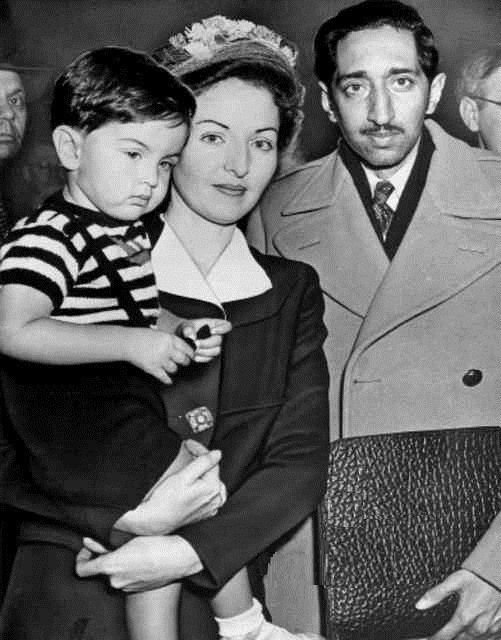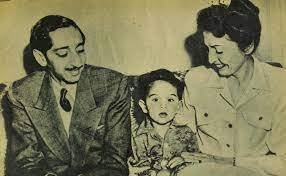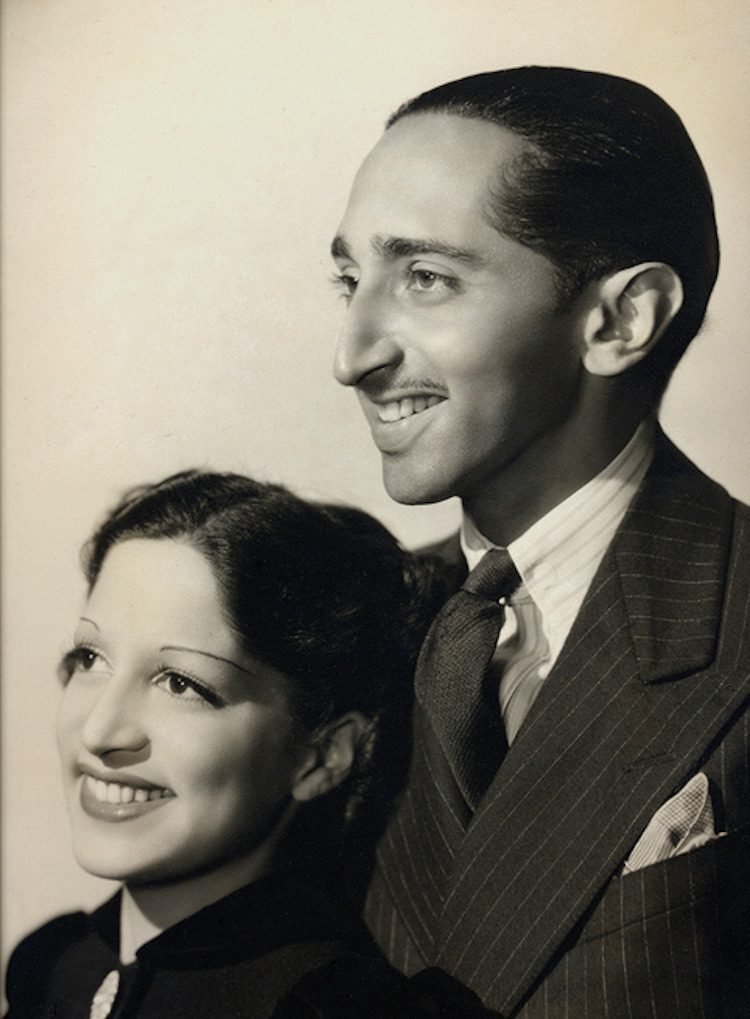THE ICONIC MAHARAJA AND MAHARANI OF INDORE: A legend of Love, Loss and Fate

Unlatching the traditional royal conduct and not giving a hoot to the countless critiques arrowed towards them, ‘the Golden Couple’ hailing from the princely state of Indore set an example of extravagant penchant for luxurious paraphernalia, hobbies and an unbeatable passion for travelling the world while enveloping a cosmopolitan lifestyle. The successor of Tukojirao Holkar III, Maharaja of Indore had a long royal name, Maharajadhiraj Raj Rajeshwar Sawai Shri Yashwant Rao II Holkar XIV Bahadur and so was the magnificence bejewelled in his love’s, Shrimant Akhand Sahib Soubhagyavati Sanyogita Bai Holkar, the queen of Indore. Whether it be fashion, furniture, design or palaces, art or jewellery the couple were way ahead of their time and engraved their names in regal trendsetters.

Their opulence was a flight of fancy to behold as they strolled in India donned in traditional Marathi attires or leisurely on their honeymoon in Europe where they spent most of their time in debonair French vêtement and both made the most of their princely privileges. They gave India a spendthrift avant garde palace, Manik Bagh which also happened to be the first modernist building in the subcontinent with an installed air conditioning.
EARLY LIFE AND SUCCESSION TO THRONE
Born on September 6, 1908, the Maharaja of Indore was brewed in both traditional and largely modern upbringing making him the most modernist Maharaja of the Holkar Dynasty. The dashing duo of Maharaja Yashwant Rai Holkar and Maharani Sanyogita Bai tied the nuptial knot at a strikingly young age in 1924. He pursued his education at Cheam School, Christ Church, and Oxford while Maharani was educated in private simultaneously in England. As Tukoji Rao Holkar III, Maharaja of Indore was allegedly involved in the murder of a dancing girl at his court in Mumbai named Mumtaz Begum, on February 26, 1926, he was forced to abdicate his throne in favour of his eighteen-year-old son, Yashwantrao Holkar II and leave Indore permanently due to the compellation by the British government. Initially, he ruled under regency until being bestowed with full powers in 1930. The couple were blessed with a daughter named Usha in 1933 who later became the heir of her father’s royal estate.

Both being young and enormously affluent, were explicit about their elegant contemporary tastes and barely spent time in India for they relished their luxurious tarriance in Europe and America where they were extravagantly entertained and thrived as members of Europe and America’s young super-elite circle. They never let go of any opportunity to mingle with celebrities, royalty, designers, creatives, and renowned artists.
The Maharaj had distinguished sharp features and tall demeanour always stroking charmingly in a french cut designer suit while the Maharani was a majestic statuesque beauty carrying a 1920s flapper castle bob and finely thin eyebrows draped in resplendent furs and gowns embellished with world’s most rarest diamonds. Photographers like Man Ray persistently accompanied them to capture the monochrome glamour and glitz with his legendary lens. Artists like Bernard Boutet de Monvel stroked dreamy portraits of them. Despite this, not many people have heard of these modernist royal duos.
Man Ray recounts how the Maharaja of Indore came to the studio in Paris dressed in western sack suit admiringly tall and sophisticated to bestow in his lap a substantial order. The following year, the Maharaja was in South of France in the company of his young bride and had booked an entire floor of a hotel in Cannes for himself and his retinue, astonishing for Ray after he arrived. He reminisces how the Maharani was an ‘exquisite girl in her teens’ wearing french clothes and a lavishly huge emerald ring the Maharaja had bought for her that morning while swanning the streets. The next day he captured a series of photographs that would account for a memorable dossier of their honeymoon. Initially, the newly wed danced to jazz music and subsequently sat, knitting hand in hand and posing in the most subtle, eloquent and aesthetically romantic ways that would inspire the generations to come.

THE ART DECO PALACE
Driven by their passion for aesthetics and profound love for innovation, the couple requisitioned the design and construction of a spectacular-modern palace in Indore called Manik Bagh (“Ruby” or “Gem Garden”) between 1930 and 1939. The lead architect was their German architect friend, Eckart Muthesius. This unparalleled eye beholding Art Deco palace was built in the new International Style, spotlighting sheer walls and gables reminiscent of Charles Rennie Mackintosh’s gleaming white modernism. Every miniscule detail of this remarkable building was fashioned in Europe. Other prominent architects involved in the project included Art Deco furniture designer Ruhlmann and Eileen Gray, Swiss designer Le Corbusier, silversmith Puiforcat, Luckhardt, and modernist Romanian sculptor Brancusi, etc.
This distinguished palace cemented the modern materials of the time: metal, synthetic leather, and glass. Each room was designed with a specific colour theme. The U-shaped Bauhaus/Art Deco palace, featuring forty rooms, marbled floors, comfy sofas and designer furniture, was completed in 1939. Wealth flowed like water in building this gem of a fortress; furniture was dismantled in Berlin and then shipped to Indore. The palace was filled with Baccarat silverware, beds by Louis Sognot, and black and orange geometric carpets designed by Ivan da Silva-Bruhns. It embodied luxury, elegance, comfort, and innovation, which, in hindsight, somewhat contradicted the socialist ideals of the modernist designers.

A MATERIALISTIC APPETITE
The Maharaja had an insatiable desire for luxury items. Together, he and Eckart Muthesius explored the studios of Berlin and France with Henri-Pierre Roche, the author of the novel Jules and Jim, who suggested them on filtering some of the exuberant decoratives to adorn Yashwant’s home. Over the years, the architect of the palace was also tasked to design the interiors of the 25-year-old Maharaja’s stylish new furnished private train, an aeroplane, a hunting caravan to chase down animals with panache, a riverboat described as a “reversionary floating modernist mansion,” and a summer palace, though the last two projects were never realised. Embracing the aristocratic lifestyle of the western world, the twitterpated couple went on to design one of the most sophisticated stables, housing the most magnificent horses that left many awestruck.
The Maharaja also had a keen eye for jewellery and instructed top jewellery houses mainly Chaumet, Harry Winston, and Van Cleef & Arpels to create the most exquisite pieces for Sanyogitabai Holkar. She was famously photographed and painted wearing the most exotic pearl-shaped diamonds known as ‘Indore Pears’, crafted by the leading diamond companies competing for her patronage.

The Maharaja was not only a prominent international connoisseur of the finest art, jewellery, furniture, but also had a thirst for vintage cars, all personally designed by him in the Art Deco style. In 1936, at the age of 27, he ordered three cars: a 4.5-litre V12 Lagonda drophead coupé, an open two-seater sports body on a supercharged SJ Duesenberg chassis, and a Bentley Aerofoil coupé, all painted in the distinctive Holkar colours of abendrot orange and zebra black. Throughout his life, he continued to amass a collection of expensive cars.
THE ITINERARY OF ‘INDORE PEARS’
On a freezing October day in 1913, Tukoji Rao Holkar III had visited the Paris Salon of the French jeweller Chaumet to gift a jewel to his wife. He was revealed two large pear-shaped diamonds weighing 46.70 and 46.95 carats, along with a sketch of a sleek necklace in the French lavalier style (a pendant, sometimes with one stone, centred from a necklace). Tukoji returned the next day to commission the necklace with the asking price of over 631,000 Francs (approximately 268,000 USD) containing the two rare natural diamonds, later known as the ‘Indore Pears’.
Eager to needle modernity into every thread of their lifestyle, in 1933, the young maharaja commissioned Mauboussin, a French jewellery maison to redesign the Chaumet necklace, substituting its fluid form with a chunkier, geometric chain. This redesign utilised natural diamonds (made popular with the influx of diamonds from Africa and advancement in machine technology) especially the popular baguette cut, and featured a significant carved green emerald. Following India’s independence in 1947, many royals, including the maharaja, were compelled to sell their jewels as auctioning their treasures was considered to be an act of shame in the royal culture. Harry Winston bought the Indore Pears in 1946, recut the diamonds, and softened the necklace’s design. Over time, the diamonds were sold and repurchased until Lebanese jeweller Robert Mouawad acquired them and set them as pendant earrings. Chaumet has since created a new collection inspired by the original necklace, featuring exceptional diamonds in the Maharani de Chaumet collection. The Indore Pears’ legacy highlights the enduring beauty and storytelling prowess of natural diamonds and their wearers.

A Love Story studded with a short shelf life
Yashwant and Sanyogita’s romantic idyll began with an arranged marriage. When they tied the knot, Sanyogita was just ten, and Yashwant was only a few years older. Sanyogita possessed a grace and charisma that could enchant anyone. Yashwant always consulted her before making decisions and treated her with immense respect. She often wore French attire with a midas touch and a large emerald-studded ring. She was dressed by the likes of Vionnet, Schiaparelli and Lanvin for many international events and dazzled among the other gems that she rubbed shoulders with! Their love story captivated famous filmmakers and actors like Cecil B. DeMille and Gary Cooper and the couple were often seen on film sets.
However, this young love had a short lifespan. Although some say Maharani died under mysterious conditions, while other people believe she was in Switzerland for a ‘cure’ and died of appendicitis during the operation at the age of 22, leaving behind their infant daughter, Usha, and a despondent maharaj. Her early untimely demise is responsible for the little information we have of her life. After Sanyogita’s death, Yashwant married twice more, but few know about the profound misery he endured after losing his true love, Sanyogita.

In 1938, the Maharaja married Marguerite Lawler from Fargo, North Dakota and unfortunately the marriage didn’t last long. After their divorce, he married Euphemia “Fay” Watt from Los Angeles, also known as Lady Fay Holkar, in 1943. With her, he had a son named Maharajkumar Shrimant Shivaji Rao “Richard” Holkar who didn’t inherit the titles and rights which were rightfully bestowed on Maharaja’s beloved daughter Usha.
LATER LIFE
On January 1, 1935, he was crowned with the title of Knight of the Order of the Indian Empire. The Maharaja set up a legislative council for Indore state and formed a cabinet with a prime minister and three ministers. After signing the instrument of accession on 11 August 1947, the state of Indore along with other 24 princely states was included in the Union of Madhya Bharat on 28 May 1948 . He served as the Up-Rajpramukh of this new state until 31 October 1956 after which he worked for the United Nations. The maharaja later died at the age of 53 in Mumbai on 5 December 1961.
K.S. Fitze, a British resident of Indore, opined like many others on the prolonged time the Maharaja spent abroad for which he faced criticism but given his educational upbringing abroad and wealth worth $70 million he was a product of western influences and loved to undertake international expeditions.
Few years back, in 2019 the Musée des Arts Décoratifs, Paris displayed an exhibition called “Moderne Maharaja” dedicated to Yashwant Rao Holkar II and his palace Manik Bagh, featuring some of the exemplifying interior pieces such as the aluminium bed by Louis Sognot and Charlotte Alix. The glamorous pair of Indore were enormously privileged, rich, somewhere carefree and maybe meant for lifetimes together, but despite of all they carved out a legacy of following one’s passion, dreams, pursuits, fulfilling every desire and set the ball rolling for making the most of one’s life for there will always be people to tear you down into pieces.


